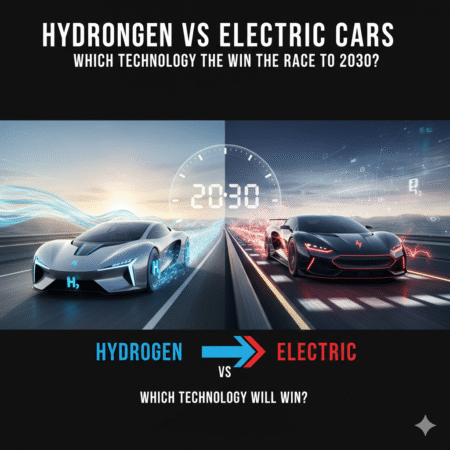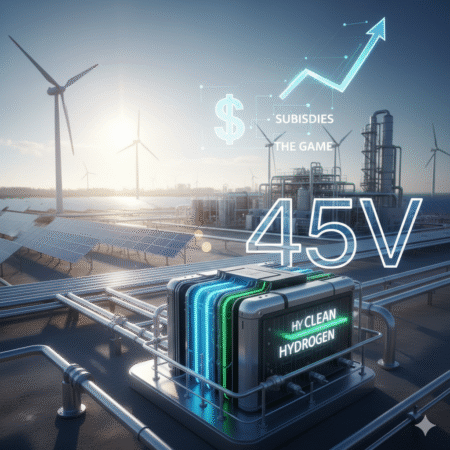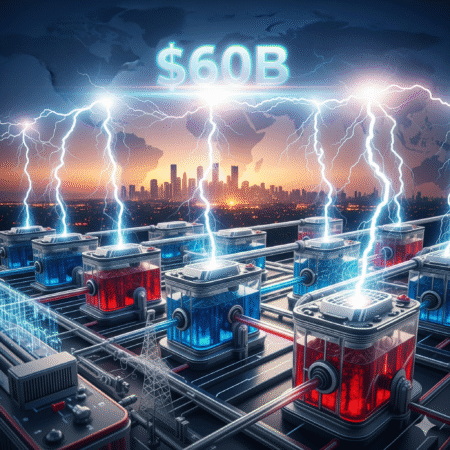
- What is the 45V Hydrogen Production Tax Credit?
- Eligibility – Who Qualifies for the 45V Credit?
- How the 45V Credit Impacts Hydrogen Production Costs
- Winners & Losers: Which Sectors Benefit Most?
- Challenges & Criticism of the 45V Credit
- The Future of Hydrogen in the US Under 45V
- Conclusion: Why 45V Could Make or Break the Hydrogen Economy
Introduction – Why 45V Tax Credit Matters in 2025
If you’ve been following the clean energy space lately, you’ve probably noticed one acronym popping up everywhere: 45V. At first glance, it sounds like a boring line of tax code only accountants care about. But here’s the kicker: this single tax credit could completely reshape the economics of hydrogen in the United States-and by extension, the global clean energy market.
Think about it. For decades, hydrogen has been hyped as the fuel of the future. We’ve heard promises about powering trucks, planes, factories, and even entire cities with zero-carbon hydrogen. But every time the industry tried to scale, one massive problem kept getting in the way: cost.
Today, producing one kilogram of green hydrogen (the kind made from renewable energy, not fossil fuels) costs anywhere from $4 to $6 per kg in most U.S. regions. That’s way too high compared to natural gas or even electricity for batteries. No steelmaker, no fertilizer plant, and certainly no trucking company was lining up to switch, no matter how much they liked the “green” label.
Enter the 45V Hydrogen Production Tax Credit, part of the Inflation Reduction Act (IRA) passed in 2022. This incentive offers up to $3 per kilogram of hydrogen produced-if it meets strict carbon intensity requirements. Suddenly, that $5/kg green hydrogen doesn’t look so expensive anymore. With 45V, producers could slash their effective costs to $2/kg or even lower. That’s right in the competitive zone with fossil fuels.
And here’s why this matters in 2025: companies, investors, and policymakers are no longer just talking about hydrogen-they’re putting real money on the table. Massive projects are being announced across the U.S., from Texas to California to the Midwest. Global giants like Air Products, Plug Power, and NextEra Energy are betting billions that 45V will trigger the hydrogen boom the world has been waiting for.
But the story isn’t just about cost. It’s about timing. The clean energy race is heating up fast. Europe is moving aggressively on hydrogen imports, Japan and South Korea are eyeing supply deals, and the U.S. doesn’t want to be left behind. The 45V credit is America’s answer to staying competitive in this trillion-dollar clean tech race.
In short: 45V isn’t some obscure tax detail-it’s the potential tipping point for hydrogen. The question now isn’t whether hydrogen will play a role, but how big that role will be-and who will capture the value first.
What is the 45V Hydrogen Production Tax Credit?
If you’ve ever wondered why suddenly every big energy company in the U.S. is talking about hydrogen, the answer is simple: money on the table. And that money comes from a game-changing policy tucked inside the Inflation Reduction Act (IRA) – the 45V Hydrogen Production Tax Credit.
Now, let’s break it down.
The 45V credit is a production-based incentive. Unlike one-time grants or capex subsidies, it rewards hydrogen producers per kilogram of hydrogen produced. And here’s the kicker: the cleaner your hydrogen is, the bigger the payout.
At its most generous level, producers can earn up to $3.00 per kilogram of clean hydrogen. That may not sound like much at first, but if you’re producing 100,000 tons of hydrogen per year (a scale many projects are targeting), you’re talking about $300 million in annual subsidies. That’s enough to completely flip the economics of hydrogen.
How 45V Works in Practice
The IRS defines eligibility based on the carbon intensity of hydrogen production, measured in grams of CO₂ equivalent per megajoule (gCO₂e/MJ).
Here’s the sliding scale:
| Carbon Intensity of Hydrogen | Credit Level (per kg H₂) | Typical Pathway |
|---|---|---|
| ≤ 0.45 gCO₂e/MJ | $3.00/kg | Renewable electrolysis (wind, solar + electrolyzer) |
| 0.45 – 1.5 gCO₂e/MJ | $1.00/kg | Low-carbon hydrogen, hybrid systems |
| 1.5 – 2.5 gCO₂e/MJ | $0.75/kg | Natural gas + partial CCS |
| 2.5 – 4 gCO₂e/MJ | $0.60/kg | Blue hydrogen (natural gas with CCS) |
| > 4 gCO₂e/MJ | No credit | Grey hydrogen (traditional fossil hydrogen) |
Duration and Timeline
- Start Date: Credits apply to hydrogen produced after January 1, 2023.
- End Date: Available for 10 years after a project begins operation (projects must start construction before 2033).
- Scope: Both new green hydrogen plants and retrofitted facilities can qualify if they meet emissions criteria.
Why This Is a Big Deal
- Predictability: Producers get a steady, per-unit incentive, making project financing much easier.
- Scalability: The more hydrogen you produce, the more credit you earn-no artificial caps.
- Technology Neutral: Whether you use solar, wind, nuclear, or CCS, as long as you meet emissions standards, you can qualify.
In short, 45V takes hydrogen from being a futuristic “maybe someday” technology to a profitable business model today. That’s why you’re suddenly seeing announcements of mega-projects from Texas to North Dakota.
The U.S. has essentially said: If you can make hydrogen clean enough, we’ll make sure you can make money from it.
Eligibility – Who Qualifies for the 45V Credit?
Here’s the million-dollar (actually, billion-dollar) question every energy company is asking in 2025: “Do we qualify for the 45V hydrogen tax credit?”
The answer isn’t as straightforward as “yes” or “no.” The IRS has laid out a set of requirements, and meeting them is the difference between turning your hydrogen project into a cash cow… or being left behind with stranded assets.
Let’s break it down step by step.
Who Can Apply?
In simple terms: any hydrogen producer operating in the U.S. can apply, as long as they can prove their production meets the carbon intensity thresholds. This includes:
- Renewable energy developers using solar, wind, hydro, or nuclear power with electrolyzers.
- Industrial gas companies (Air Liquide, Linde, Air Products) expanding into clean hydrogen.
- Oil & gas majors (ExxonMobil, Chevron, Shell) retrofitting plants with carbon capture systems.
- New startups building green hydrogen hubs with private and government funding.
The Carbon Intensity Requirement
The backbone of eligibility is carbon intensity (CI), measured in grams of CO₂ equivalent per megajoule (gCO₂e/MJ). The cleaner the hydrogen, the higher the tax credit.
Here’s how the IRS defines the tiers:
| Tier | Carbon Intensity (gCO₂e/MJ) | Credit Amount | Typical Production Pathway |
|---|---|---|---|
| Tier 1 | ≤ 0.45 | $3.00/kg | Green hydrogen (renewable electrolysis, nuclear-powered electrolysis) |
| Tier 2 | 0.45 – 1.5 | $1.00/kg | Hybrid pathways, grid-connected with renewable offsets |
| Tier 3 | 1.5 – 2.5 | $0.75/kg | Blue hydrogen (natural gas + CCS with ~75–85% capture) |
| Tier 4 | 2.5 – 4 | $0.60/kg | Blue hydrogen with lower capture rates |
| Ineligible | > 4 | $0.00/kg | Grey hydrogen (traditional fossil-based) |
Does Blue Hydrogen Qualify?
Yes, but with a catch.
- If carbon capture efficiency is high enough, blue hydrogen can qualify under Tier 3 or Tier 4.
- However, many projects struggle with methane leakage in natural gas supply chains, which can raise carbon intensity and reduce credit eligibility.
- This is why critics argue the IRS may tighten rules for blue hydrogen to prevent greenwashing.
What About Green Hydrogen?
This is where things get exciting.
- Green hydrogen projects powered by 100% renewables can qualify for the full $3.00/kg credit.
- Nuclear-powered hydrogen is also included, giving utilities with nuclear plants a massive new revenue stream.
- But to prove eligibility, producers must use hourly matching of renewable electricity (not just annual averages). That means if your electrolyzer runs at night, you can’t claim solar credits unless you have batteries or other storage solutions.
Documentation and Compliance
To claim 45V, producers must:
- Provide verified lifecycle emissions data for their hydrogen production.
- Use recognized models like GREET (Greenhouse gases, Regulated Emissions, and Energy use in Technologies).
- Undergo third-party audits to avoid fraud and double counting of renewable energy credits.
Bottom line: Not every hydrogen project will qualify. Only the cleanest and best-documented ones will unlock the full $3/kg windfall. For everyone else, the payout shrinks – and so does the business case.
How the 45V Credit Impacts Hydrogen Production Costs
Here’s where things get real. Everyone in the energy world is talking about 45V, but the real question is:
Can this tax credit actually make hydrogen cheap enough to compete with fossil fuels and batteries?
Because let’s be honest: hydrogen has always suffered from the same problem – it’s too expensive. Producing clean hydrogen from electrolysis typically costs $5–6 per kilogram, while natural gas-derived grey hydrogen is much cheaper, around $1.50/kg. For years, this price gap has been the reason hydrogen projects couldn’t scale.
Now, enter 45V – a policy designed to flip the economics.
Read More: Hydrogen Is the New Oil? How Industrial Giants Are Racing to Go Green
Before 45V vs After 45V
Let’s look at the numbers:
| Hydrogen Type | Production Cost (2024, Before 45V) | After 45V Credit | Effective Cost per kg |
|---|---|---|---|
| Grey Hydrogen | $1.50–2.00 | ❌ Not Eligible | $1.50–2.00 |
| Blue Hydrogen | $3.00–4.50 | $0.60–$0.75 Credit | $2.25–3.90 |
| Green Hydrogen | $5.00–6.00 | $3.00 Credit | $2.00–3.00 |
That last line is the real game-changer. Suddenly, green hydrogen becomes cost-competitive with fossil fuels – and in some regions, even cheaper.
Why This Matters
- For Heavy Industry: Steel, cement, and ammonia producers can now consider hydrogen as a real alternative to coal and natural gas.
- For Transportation: Fuel cell trucks, buses, and ships finally have a fighting chance against diesel.
- For Exports: U.S. hydrogen could undercut international competitors, especially in Europe and Asia where carbon taxes are stricter.
Cost Comparison with Alternatives
If you zoom out, hydrogen doesn’t just compete with itself – it competes with fossil fuels and EV batteries. Here’s a quick snapshot:
| Energy Source | Cost per Unit | Notes |
|---|---|---|
| Diesel | ~$2.50/gal equivalent | Cheap but high emissions |
| Natural Gas | ~$2–3/MMBtu | Low cost, but methane leakage issues |
| EV Batteries | ~$100–150/kWh | Falling fast, but raw materials volatile |
| Green Hydrogen (Post-45V) | ~$2–3/kg | Clean + scalable |
This puts hydrogen in a sweet spot – especially for sectors where batteries can’t deliver (heavy-duty transport, industrial heat, long-term storage).
The Ripple Effect
When costs fall, adoption accelerates. Here’s what could happen:
- Hydrogen hubs become economically viable across the U.S.
- Private investors pour money into electrolysis, pipelines, and storage.
- Oil & gas companies may rebrand themselves as “hydrogen players” to capture subsidies.
- Global competition heats up, as the EU and Asia race to match U.S. incentives.
Bottom line: The 45V credit isn’t just lowering hydrogen prices – it’s rewriting the entire economics of the hydrogen industry. For the first time, clean hydrogen is no longer a “someday” technology. It’s here, and it’s cost-competitive.
Winners & Losers: Which Sectors Benefit Most?
If you think the 45V hydrogen tax credit is just about lowering costs, think again. It’s about shifting entire industries. Some sectors will come out as big winners, while others may face headwinds. Let’s break it down.
The Big Winners
- Hydrogen Fuel Cell Vehicles (FCEVs)
- Automakers like Toyota, Hyundai, and even truck companies (Nikola, Hyundai Xcient, Daimler) get a lifeline.
- Lower hydrogen prices mean running costs for hydrogen trucks and buses could finally compete with diesel.
- Expect hydrogen refueling stations to get more funding and expansion in US highways.
- Heavy Industry (Steel, Cement, Ammonia)
- These sectors are tough to decarbonize – you can’t just “plug in” renewable electricity.
- Hydrogen is a direct substitute for coal in steelmaking and a key feedstock for ammonia and fertilizer.
- 45V could slash operating costs and make green steel and green ammonia actually competitive.
- Export Opportunities
- With subsidies, the US could produce hydrogen (and derivatives like ammonia) cheaper than Europe or Asia.
- That opens the door to hydrogen exports to Japan, Korea, and Germany – markets desperate for clean molecules.
- Think of it as the US positioning itself as the “Saudi Arabia of clean hydrogen.”
The Potential Losers
- Traditional Oil & Gas
- Refiners who rely on “grey hydrogen” (made from natural gas without carbon capture) will see their cost advantage vanish.
- Blue hydrogen producers (with CCS) may still qualify, but they face stricter emission thresholds that cut profitability.
- Battery-First EV Market
- Hydrogen vehicles getting cheaper could challenge the EV narrative, especially for heavy-duty transport.
- Tesla won’t feel the hit tomorrow, but by 2030, long-haul hydrogen trucks could bite into EV market share.
Winners vs. Losers Table
| Category | Winners | Losers |
|---|---|---|
| Transportation | Hydrogen trucks, buses, trains | Pure battery EVs (in heavy-duty segment) |
| Industry | Steel, cement, fertilizer plants | Grey hydrogen producers (natural gas-based) |
| Energy Market | US exporters to EU/Asia | Oil & gas refiners dependent on fossil H₂ |
| Investors | Hydrogen startups, electrolyzer makers | Companies slow to adapt (legacy O&G) |
Why This Matters
The 45V credit isn’t just a tax break. It’s a market signal: if you’re in hydrogen, the US government has your back. If you’re stuck in fossil-heavy models, you’ll be playing defense.
Challenges & Criticism of the 45V Credit
Here’s the thing: while the 45V hydrogen tax credit sounds like a golden ticket, it’s not without drama. Investors, regulators, and even environmental groups are already clashing over how this incentive is applied. And honestly? These challenges could decide whether 45V becomes a clean energy revolution or just another subsidy loophole.
The Major Challenges
- Double Counting Renewable Energy
- To qualify, hydrogen must be produced with low-carbon electricity. But what if the same solar or wind project is “counted twice”—once for hydrogen, once for power sales?
- This accounting trick could inflate claims, making hydrogen look cleaner on paper than it actually is.
- Greenwashing Concerns
- Critics argue some producers might label their product “clean hydrogen” while still relying heavily on natural gas.
- Without strict monitoring, blue hydrogen could exploit loopholes, especially if carbon capture performance is overstated.
- Unclear IRS Guidance
- The IRS has yet to finalize some rules, like how emissions intensity will be calculated or what lifecycle analysis (LCA) tools must be used.
- This uncertainty makes it tough for developers to model project economics or secure financing.
- Infrastructure Bottlenecks
- Even if hydrogen becomes cheaper, transporting and storing it at scale is still expensive.
- Pipelines, storage facilities, and refueling stations are nowhere near ready for the boom 45V promises.
- Equity and Regional Disputes
- States with high renewable capacity (Texas, California) will attract most investments, leaving others behind.
- Expect political pushback from regions that don’t get their “fair share” of the hydrogen pie.
Table: 45V Criticism at a Glance
| Challenge | Why It Matters | Who’s Affected |
|---|---|---|
| Double counting renewables | Can inflate hydrogen’s “clean” score | Regulators, environmental watchdogs |
| Greenwashing risks | Dirty hydrogen could qualify for subsidies | Climate activists, taxpayers |
| Unclear IRS rules | Creates uncertainty in project financing | Investors, project developers |
| Infrastructure gaps | Delays real-world adoption | Transportation & industry |
| Regional equity disputes | Uneven growth across states | Policymakers, local economies |
Why These Criticisms Matter
The 45V credit is worth up to $3/kg – that’s a massive subsidy. But if it gets abused, the entire program could lose credibility. Worse, billions in taxpayer dollars could flow to projects that don’t really cut emissions.
For investors and companies, this means one thing: watch the fine print. Don’t just chase the subsidy; make sure your hydrogen is genuinely clean, your supply chain is solid, and your project can withstand regulatory scrutiny.
The Future of Hydrogen in the US Under 45V
Here’s the big question: what does the 45V credit actually mean for the future of hydrogen in the US?
If you’re an investor, policymaker, or industry player, the stakes are massive. We’re not just talking about shaving a few dollars off production costs – we’re talking about reshaping entire industries, unlocking billions in new capital, and potentially putting the US at the center of the global hydrogen race.
Investment Projections to 2035
With 45V offering up to $3/kg, the economics of hydrogen suddenly flip.
Analysts estimate:
- $100–$200 billion in hydrogen-related investments could pour into the US by 2035.
- Electrolyzer capacity is expected to grow 10x by 2030.
- Hydrogen hubs (Texas, California, Midwest) will become global case studies in scaling clean hydrogen.
Global Hydrogen Market Impact
The US isn’t operating in a vacuum. Europe and Asia are also betting big on hydrogen, but the 45V subsidy gives the US a first-mover cost advantage.
- Europe: Faces higher electricity prices, making US hydrogen potentially 20–30% cheaper.
- Asia (Japan, South Korea): Huge import demand for green ammonia and hydrogen derivatives.
- Middle East: Competing with mega-projects, but the US has a domestic market edge.
If US hydrogen drops below $2/kg, exports could surge – turning America from an energy importer into a clean energy exporter.
Table: US Hydrogen Future Scenarios Under 45V
| Scenario | What It Looks Like | Key Takeaway |
|---|---|---|
| Optimistic | $200B+ investment, hydrogen <$2/kg, US becomes top global exporter | US dominates global clean hydrogen |
| Moderate | $100B investment, hydrogen $2–3/kg, steady growth in heavy industry use | US secures domestic adoption first |
| Pessimistic | Regulatory delays, infrastructure bottlenecks, subsidies misused | Momentum stalls, EU/Asia take the lead |
What Investors & Companies Should Watch
- IRS Final Guidance → Will determine how clean hydrogen is measured.
- Infrastructure Rollout → Pipelines, storage, and export terminals are critical.
- Corporate Offtake Deals → Long-term purchase agreements will make or break projects.
- Global Price Signals → LNG, oil, and renewable costs will all impact hydrogen’s competitiveness.
The Bottom Line
The 45V credit isn’t just a subsidy; it’s a market shifter. Done right, it could slash costs, attract capital, and set the US up as the world’s clean hydrogen powerhouse. Done wrong, it risks wasting billions and letting other regions take the lead.
Conclusion: Why 45V Could Make or Break the Hydrogen Economy
Let’s be real – the 45V hydrogen production tax credit is not just another line in the U.S. tax code. It’s a turning point. It’s the difference between hydrogen staying a “future energy” buzzword and hydrogen actually becoming a scalable, investable, and profitable reality.
The subsidy is bold: up to $3/kg for clean hydrogen. On paper, that’s a massive cut in production costs. But the bigger story is what it unlocks: billions in private capital, new infrastructure, global partnerships, and entirely new industries that rely on hydrogen.
Key Takeaways
If you’ve skimmed this far, here’s the core message:
- Hydrogen is going mainstream – the 45V credit accelerates its adoption by making it competitive with fossil fuels.
- Winners will move fast – companies that secure off-take agreements and build early projects will dominate the market.
- It’s not risk-free – regulation, infrastructure, and emissions accounting still have big question marks.
- Global ripple effect – the U.S. is setting the benchmark, and other regions (EU, Asia, Middle East) will either compete or partner.
Table: 45V Hydrogen Credit – Pros & Cons
| Pros (Opportunities) | Cons (Risks/Challenges) |
|---|---|
| Up to $3/kg subsidy makes hydrogen cost-competitive | Regulatory uncertainty on emissions rules |
| Attracts $100B+ investments into U.S. clean energy | Potential greenwashing & misuse of credits |
| Boosts heavy industry decarbonization | Infrastructure (pipelines, storage) still lacking |
| Creates export potential (green ammonia, fuels) | Global competition from EU, Middle East |
| Strengthens U.S. energy security & leadership | Policy shifts could derail momentum |
Why It Matters for You
Whether you’re an investor, policymaker, engineer, or simply an energy nerd, here’s the deal:
- If you invest, 45V is creating a trillion-dollar opportunity.
- If you work in energy, hydrogen could reshape your industry in the next decade.
- If you watch policy, the U.S. is showing how subsidies can accelerate the energy transition.
This is not just about clean energy – it’s about who wins the future economy.
Call-to-Action
The 45V tax credit could make or break the hydrogen economy. The winners will be those who understand the details, act early, and stay ahead of the curve.
👉 Stay plugged into the latest on hydrogen policy, projects, and market trends – not just in the U.S., but also in Europe, Asia, and the Middle East. Because clean hydrogen isn’t just an energy play. It’s the new global race.





